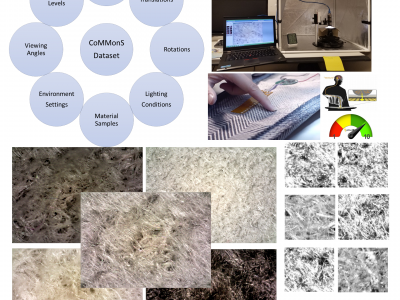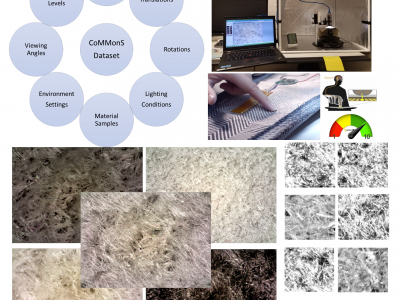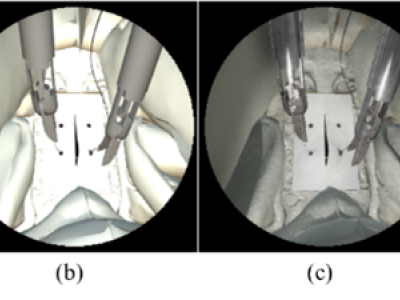Artificial Intelligence
As one of the research directions at OLIVES Lab @ Georgia Tech, we focus on recognizing textures and materials in real-world images, which plays an important role in object recognition and scene understanding. Aiming at describing objects or scenes with more detailed information, we explore how to computationally characterize apparent or latent properties (e.g. surface smoothness) of materials, i.e., computational material characterization, which moves a step further beyond material recognition.
- Categories:
 935 Views
935 ViewsAs one of the research directions at OLIVES Lab @ Georgia Tech, we focus on recognizing textures and materials in real-world images, which plays an important role in object recognition and scene understanding. Aiming at describing objects or scenes with more detailed information, we explore how to computationally characterize apparent or latent properties (e.g. surface smoothness) of materials, i.e., computational material characterization, which moves a step further beyond material recognition.
- Categories:
 269 Views
269 ViewsThe dataset consists of the following columns:
Data description
ColumnDescriptiongift_idUnique ID of giftgift_typeType of gift (clothes/perfumes/etc.)gift_categoryCategory to which the gift belongs under that gift typegift_clusterType of industry the gift belongsinstock_dateDate of arrival of stockstock_update_dateDate on which the stock was updatedlsg_1 - lsg_6Anonymized variables related to giftuk_date1, uk_date2Buyer related datesis_discountedShows whether the discounted is applicable on the giftvolumesNumber of packages boughtpriceThe total price
- Categories:
 266 Views
266 ViewsThis dataset was used and described in detail in the following publication. The Effects of Different Levels of Realism on the Training of CNNs with only Synthetic Images for the Semantic Segmentation of Robotic Instruments in a Head Phantom. Heredia-Perez, S. A.; Marinho, M. M.; Harada, K.; and Mitsuishi, M. International Journal of Computer Assisted Radiology and Surgery (IJCARS). 2020. https://doi.org/10.1007/s11548-020-02185-0
- Categories:
 312 Views
312 Views
Real-Life Diabetogenic (RLD) database is built for evaluating the cross-modal retrieval algorithm in real-life dietary environment, and it has 4500 multimodal pairs in total,where each images can be related to multiple texts and each text can be related to multiple images.
For more details, you can refer to our paper: P. Zhou, C. Bai, J. Xia and S. Chen, "CMRDF: A Real-Time Food Alerting System Based on Multimodal Data," in IEEE Internet of Things Journal, doi: 10.1109/JIOT.2020.2996009.
Please cite the above paper if you use this database.
- Categories:
 450 Views
450 ViewsThis dataset contains the trained model that accompanies the publication of the same name:
Anup Tuladhar*, Serena Schimert*, Deepthi Rajashekar, Helge C. Kniep, Jens Fiehler, Nils D. Forkert, "Automatic Segmentation of Stroke Lesions in Non-Contrast Computed Tomography Datasets With Convolutional Neural Networks," in IEEE Access, vol. 8, pp. 94871-94879, 2020, doi:10.1109/ACCESS.2020.2995632. *: Co-first authors
- Categories:
 3818 Views
3818 Views
We will upload final abstract here after IEEE sensors review process
- Categories:
 485 Views
485 Views
In this paper, a sliding mode adaptive control strategy is proposed to improve driving comfort effectivelyunder the conditions of ensuring driving safety and limited suspension travel.Considering the non-linear characteristics of the asymmetric single-rod hydraulic actuator with a small occupied volume, the uncertainty of the parameters of the body mass, the friction of the suspension components and the unmodeled dynamics of the system, a half-vehicle active suspension model wasestablished. The adaptive law is designed to combine sliding mode and adaptive algorithms.
- Categories:
 114 Views
114 Views
The nucleus and micronucleus images in this dataset are collected manually from Google images. Many of these images are in RGB color while a few of them are in grayscale. The dataset includes 148 nucleus images and 158 micronucleus images. The images are manually curated, cropped, and labeled into these two classes by a domain of experts in biology. The images have different sizes and different resolutions. The sizes and shapes for nucleuses and micronucleuses images differ from one image to another. Each image may contain one or more nucleus or micronucleus.
- Categories:
 311 Views
311 ViewsThis data set includes Covid-19 related Tweet messages written in Turkish that contain at least one of four keywords (Covid, Kovid, Corona, Korona). These keywords are used to express Covid-19 virus in Turkey. Tweets collection was started from 11th March 2020, the first Covid-19 case seen in Turkey.
Currently dataset contain 4,8 million tweets with 6 different attribute of each tweets that were sent from 9 March 2020 until 6 May 2020.
The data file contains comma separated values (CSV). It contains the following information (6 Column) for each tweet in the data file:
- Categories:
 5648 Views
5648 Views




